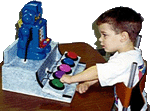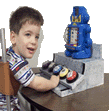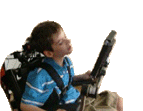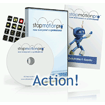|
The easy-to-use binder featuring 800 Questions and Answers and
800 Practice Activities provides teachers and counselors with
high-interest subjects that are simple enough for students of all
ages to understand, yet challenging enough to inspire lively
discussion of the various life skills.
This comprehensive and well-organized manual offers a convenient and
flexible way to conduct life skills instruction in a group
discussion format. It is ideal for use with all size groups in a
home or work setting, an entire classroom, or for one-on-one
counseling sessions. The fast-paced group format allows participants
to express their feelings on a wide ranging variety of subjects and
also to learn more about their peers. This in turn teaches the most
important life skill of all: the social skill of getting along with
and showing respect for the feelings and opinions of others. A
special section entitled "How to Get Started" gives educators
step-by-step instructions and tips on getting the most out of the
materials enclosed.
Topics Covered:
Behavior
Focuses on which behaviors that are acceptable and which are not
acceptable in various settings such as home, school, work, and in
the community. Life skill topics include: taking responsibility for
own actions; showing anger in acceptable ways; respecting the
rights, feelings, and property of others; learning when an apology
is needed; learning to tell the truth; coping with people who yell,
hit, or threaten others, and more.
Communication
Focuses on knowing what personal or basic orientation information
they may need to communicate to others. Skill topics include:
learning basic identification and survival information, names of
peers and other people in their lives, identifying two or more
trusted people, days of the week, choosing the correct restroom,
functional time management, importance of carrying an ID, and more.
Community
Activities teach basic skills needed to safely utilize community
resources with maximum independence. Skill topics include: name of
neighborhood, city and state; rights of all people in the community;
utilizing the library, post office, grocery store, medical
facilities and bank; identifying community helpers; danger of
strangers; what to do if lost, and more.
Cooking
Activities reinforce cooking instruction in a kitchen setting. Skill
topics include: kitchen safety and sanitation; identify cooking
ingredients; choosing correct utensils, pots and pans; definition of
basic cooking terms; using measuring spoons and cups; how to use the
stovetop, a toasteroven and a microwave; using potholders; meal
planning; making a shopping list, and more.
Grooming
Promotes discussion of all aspects of grooming and personal hygiene.
Skill topics include: taking responsibility for own appearance;
importance of bathing regularly; privacy issues while grooming and
dressing; hand washing hygiene; when to use deodorant; wearing clean
clothes; clothing choices for school and work; bushing and flossing
teeth; bathroom safety, and more.
Mealtime
Activities focus on basic table manners and eating safety. Skill
topics include: acceptable and unacceptable mealtime behavior; using
a knife and fork to cut; chewing with mouth closed; appropriate
dinner conversation; eating at restaurants; setting the table; how
to avoid choking on food; household eating rules; food allergies,
and more.
Self-Awareness
Activities encourage participants to learn about themselves and each
other. Skill topics include: recognizing positive traits about self,
peers, teachers, and other people in their lives; showing respect
for feelings of others; standing up for own rights; dealing with
peer pressure; treating people and property with respect; making
good decisions; acceptable ways to calm down when angry, and more.
Workplace
Focuses on exploring vocational interests and finding and keeping a
job. Skill topics include: business hours of local work places;
information on a job application; basics of a job interview;
supervisor and work-worker relationships; acceptable and unacceptable
workplace behaviors; workplace attendance and punctuality; following
dress codes; calling sick to a workplace, and more.
Also Available:
|





